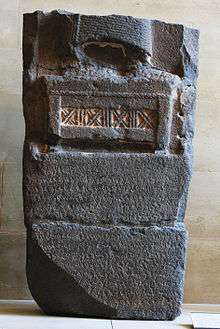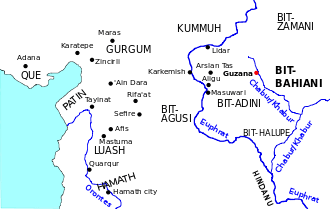Zakkur
Zakkur (or Zakir) was the ancient king of Hamath and Luhuti (also known as Nuhašše) in Syria. He ruled around 785 BC. Most of the information about him comes from his basalt stele, known as the Stele of Zakkur.

History
Not so much is known about Zakkur. He is first mentioned in Assyrian sources in 808 BC, at the time of Adad-nirari III. Adad-nirari ordered his commander Shamshi-ilu to mediate the border dispute between Zakkur and Atarshumki I of Arpad.[1]

Zakkur appears to have been a native of 'Ana' (which may refer to the city of Hana/Terqa) on the Euphrates River, that was within the influence of Assyria.[2]
Zakkur is believed to have founded the Aramean dynasty at the city of Hamath (now known as Hama).[3] Some scholars consider him as an usurper, because, previously, Hamath was ruled by the kings with Luwian or neo-Hittite names.[4]
Luhuti, over which Zakkur came to rule, is known primarily from Assyrian inscriptions.[4] Nevertheless, these inscriptions describe Luhuti as a country with many cities and troops.[5]
The capital of Luhuti was the city of Hazrik (modern Tell Afis; it was known as Hatarikka for the Assyrians),[6][7] located 45 kilometers south of Aleppo.[8] This is where the Zakkur Stele was found.
Luhuti was incorporated into Hamath around 796 BC;[6] it formed the northern province of the kingdom.[9]
Events described in the Stele
Zakkur was besieged in Tell Afis by a coalition of Aramean kings incited by Ben-Hadad III of Aram-Damascus,[10] and led by the king of Bit Agusi.[11] Zakkur survived the siege and commemorated the event by commissioning the Stele of Zakkur.[12]
See also
- Aram (biblical region)
References
- Edward Lipiński, On the Skirts of Canaan in the Iron Age: Historical and Topographical Researches. Volume 153 of Orientalia Lovaniensia analecta, Peeters Publishers, 2006 ISBN 9042917989
- Alan R. Millard, The Homeland of Zakkur, Semitica 39 [M. Sznycer Volume] (1990): 47-52.
- Scott B. Noegel, The Zakkur Inscription. In: Mark W. Chavalas, ed. The Ancient Near East: Historical Sources in Translation. London: Blackwell (2006), 307-311
- John David Hawkins. Corpus of Hieroglyphic Luwian Inscriptions: Volume 1, Inscriptions of the Iron Age: Part 1. pp. 400-401.
- Trevor Bryce. The World of The Neo-Hittite Kingdoms: A Political and Military History. p. 132.
- Trevor Bryce. The Routledge Handbook of the Peoples and Places of Ancient Western Asia. p. 296.
- I. E. S. Edwards; Cyril John Gadd; Nicholas Geoffrey Lemprière Hammondpage. The Cambridge Ancient History: Early History of the Middle East. Part 2, Volume 1. p. 282.
- Holman Concise Bible Dictionary. p. 282.
- Trevor Bryce. The Routledge Handbook of the Peoples and Places of Ancient Western Asia. p. 282.
- John Boardman. The Cambridge Ancient History: The prehistory of the Balkans; and the Middle East and the Aegean world, tenth to eighth centuries B.C.. Volume 3. Part 1. p. 403.
- Trevor Bryce. The World of The Neo-Hittite Kingdoms: A Political and Military History. p. 166.
- James Maxwell Miller. A History of Ancient Israel and Judah. p. 303.
Bibliography
- Scott B. Noegel, The Zakkur Inscription. In: Mark W. Chavalas, ed. The Ancient Near East: Historical Sources in Translation. London: Blackwell (2006), 307-311.
- M. Henri Pognon, Inscriptions semitiques de la Syrie, de la Mesopotamie at de la region de Mossoul, Paris, 1907 (and 1908). The volume contains 116 inscriptions most of them in Syriac.
- James J. Montgomery, A New Aramaic Inscription of Biblical Interest in The Biblical World, Vol. XXXIII, Febr. 1909, p. 79-84.
- Pritchard, The Ancient Near East, ANET 501-502
External links
- The Aramaic Inscription of Zakar, King of Hamath www.aramaic-dem.org
- The kings of ancient Hamath historyfiles.co.uk